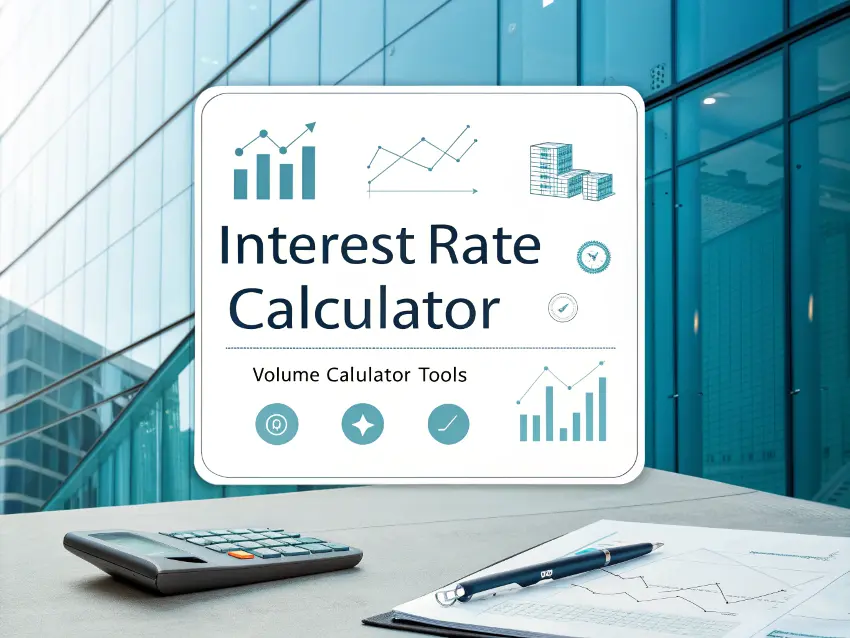Interest Rate Calculator
Convert and compare different interest rate types

Interest Rate Calculations
Understanding Interest Rates:
Interest rates are expressed in different ways depending on the context and calculation method. Converting between these formats helps you understand the true cost of loans and returns on investments.
Calculation Types:
APR to APY Conversion
Convert Annual Percentage Rate (APR) to Annual Percentage Yield (APY)
APY to APR Conversion
Convert Annual Percentage Yield (APY) to Annual Percentage Rate (APR)
Effective Interest Rate
Calculate the effective interest rate with different compounding frequencies
Loan Offer Comparison
Compare different loan offers with varying rates and fees
Payment Period Adjustment
Convert between rates for different payment periods (monthly, weekly, etc.)
Key Terminology
- APR (Annual Percentage Rate): The yearly interest rate without accounting for compounding
- APY (Annual Percentage Yield): The effective yearly rate when compounding is considered
- Nominal Rate: The stated rate without considering compounding frequency
- Effective Rate: The actual rate accounting for compounding effects
- Compounding: The process where interest earns interest on itself
APR to APY Conversion
%
APR of 5% compounded monthly equals
0.0000% APY
Calculation Formula:
APY = (1 + APR/n)n - 1
Where n is the number of compounding periods per year (12)
What This Means:
A stated rate (APR) of 5% that compounds monthly will actually yield 0.0000% in annual returns. The APY accounts for the effect of compounding, making it the true rate of return you'll receive on an investment or the actual rate you'll pay on a loan.
Interest Rate Concepts Explained
Why Different Interest Rate Formats Matter
For Borrowers
Understanding the true cost of loans through APR helps you compare offers fairly. A loan with a lower stated rate might actually be more expensive when fees and compounding are considered.
For Investors
Looking at APY rather than simple interest rates helps you accurately project investment growth and compare different investment options with various compounding frequencies.
For Financial Analysis
Converting between rate formats allows for accurate financial modeling, present value calculations, and decision-making when different time periods are involved.
The Impact of Compounding
Compounding causes interest to grow exponentially rather than linearly. This effect becomes more pronounced:
1
With higher interest rates
The difference between APR and APY increases as the interest rate increases. At 10%, the difference is more significant than at 2%.
2
With more frequent compounding
Daily compounding produces a higher effective rate than monthly compounding, which is higher than annual compounding.
3
Over longer time periods
The power of compounding becomes more dramatic over time, which is why small differences in interest rates can lead to large differences in accumulated interest over decades.
Frequently Asked Questions
Why is APY always higher than APR for the same interest rate?
APY accounts for the effects of compounding, which allows interest to earn interest on itself. This compounding effect always results in a higher effective rate than the stated APR, except in the case of annual compounding where APR and APY are equal.
Why do lenders advertise APR while savings accounts advertise APY?
It's a marketing strategy: lenders want their rates to appear lower (APR is lower than APY), while savings institutions want their returns to appear higher (APY is higher than APR). This is why it's important to understand both concepts to make fair comparisons.
What's the difference between nominal and effective interest rates?
The nominal rate is the stated rate without considering compounding (similar to APR). The effective rate accounts for the impact of compounding frequency (similar to APY). For example, a credit card might have a nominal rate of 18% APR but an effective rate of 19.56% when compounded monthly.
How do these calculations apply to loan amortization?
In loan amortization (like mortgages), lenders typically use the periodic interest rate (annual rate divided by number of payments per year) to calculate each payment. Understanding the difference between APR and effective rates helps borrowers comprehend why making biweekly instead of monthly payments can save significant interest over the life of a loan.